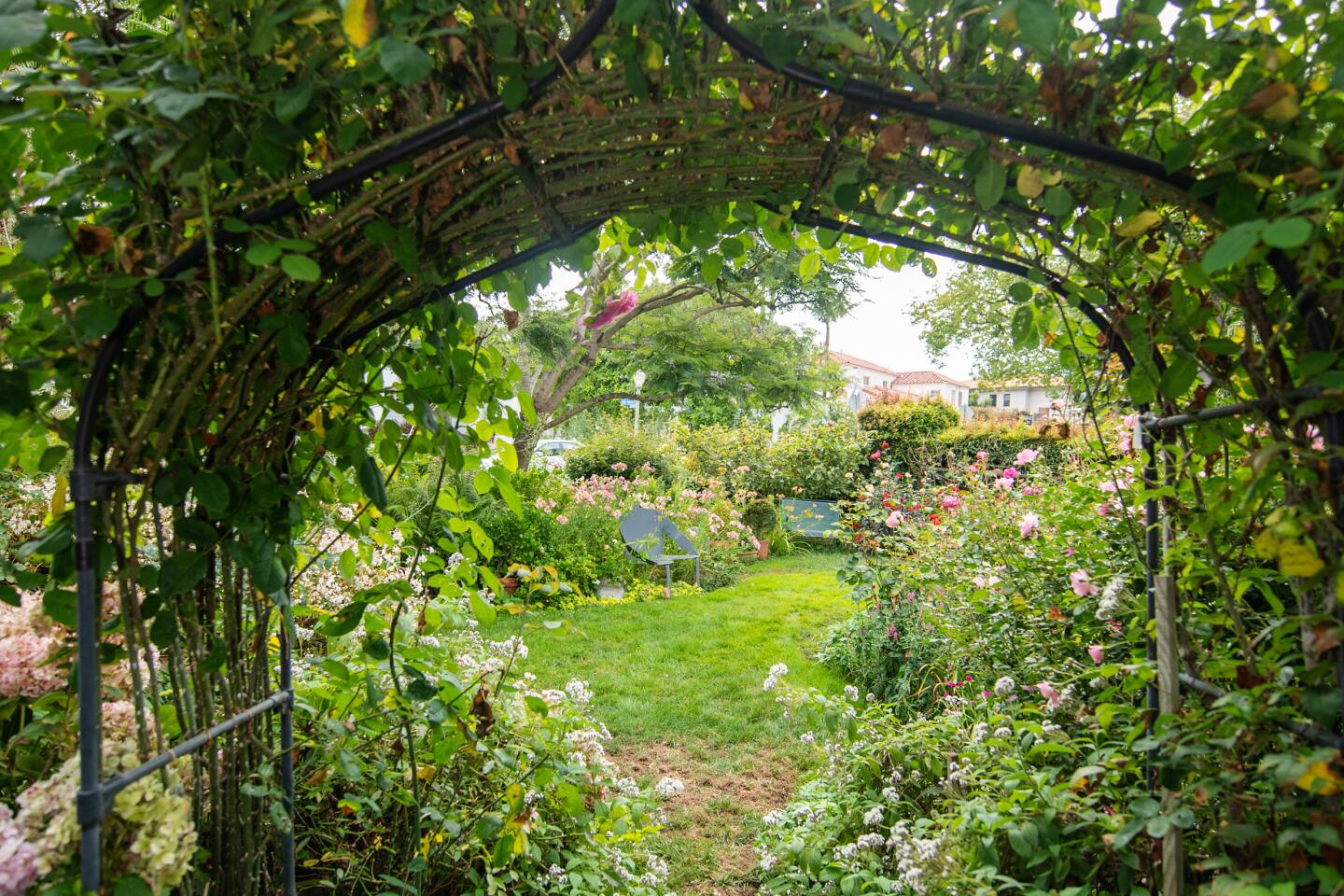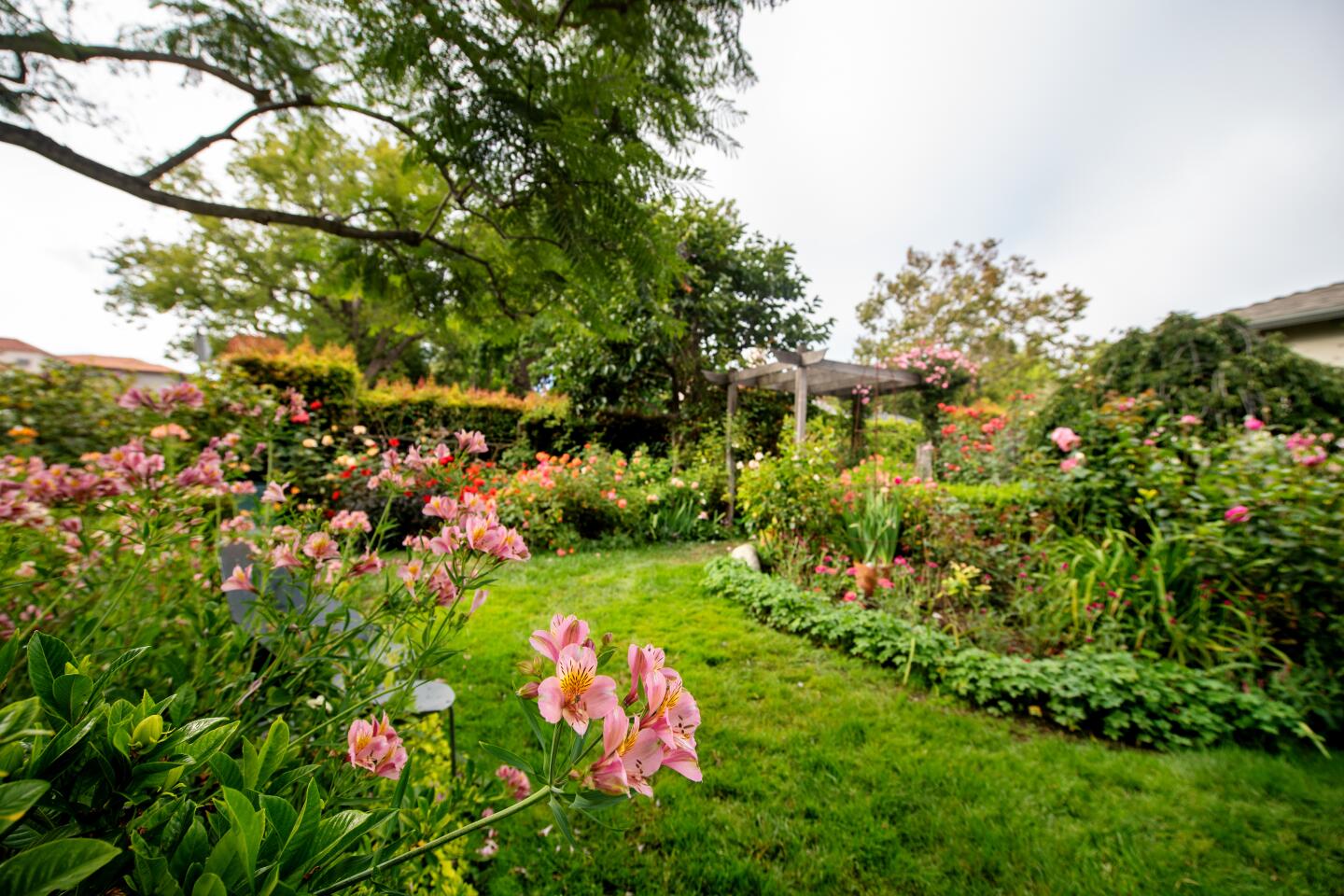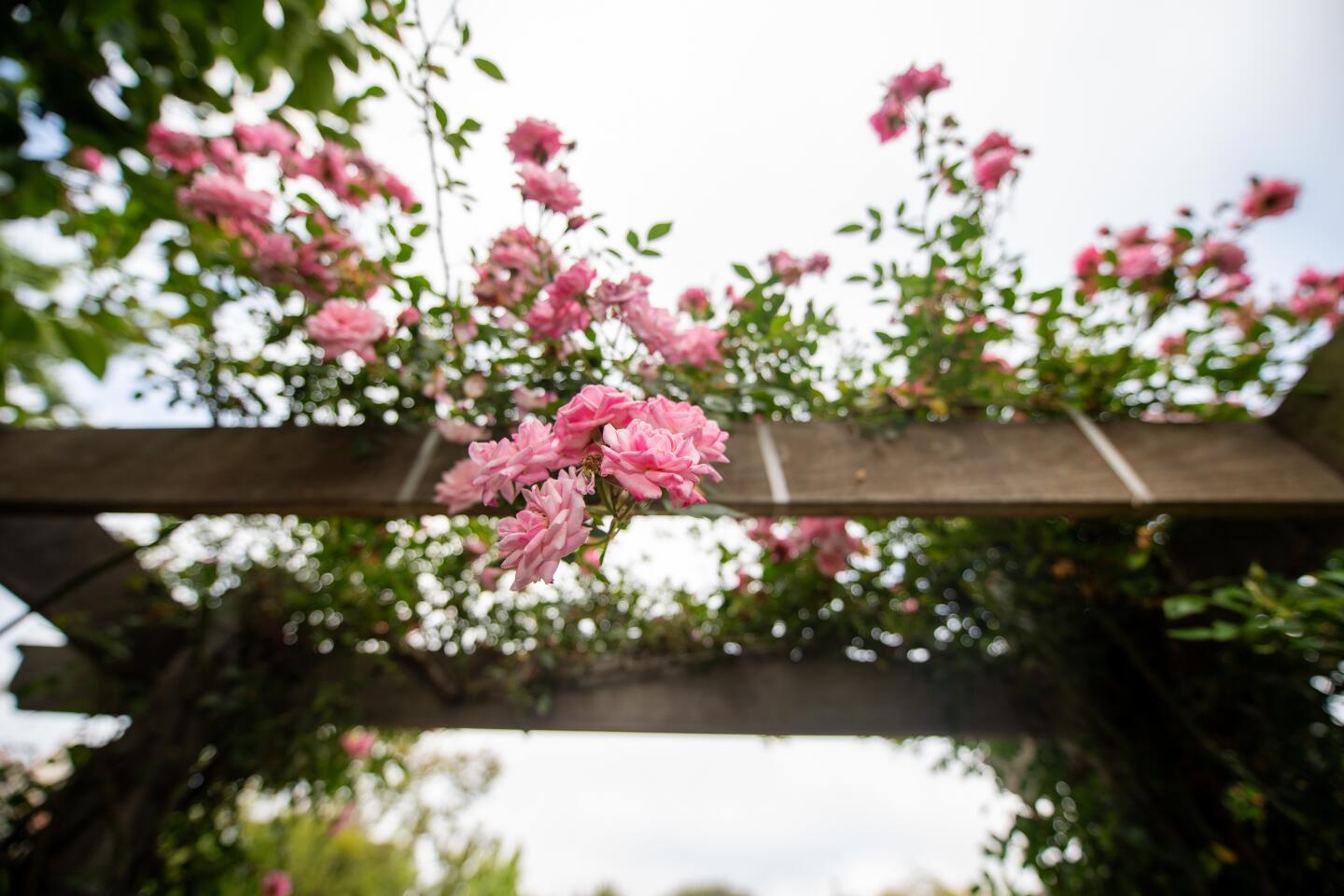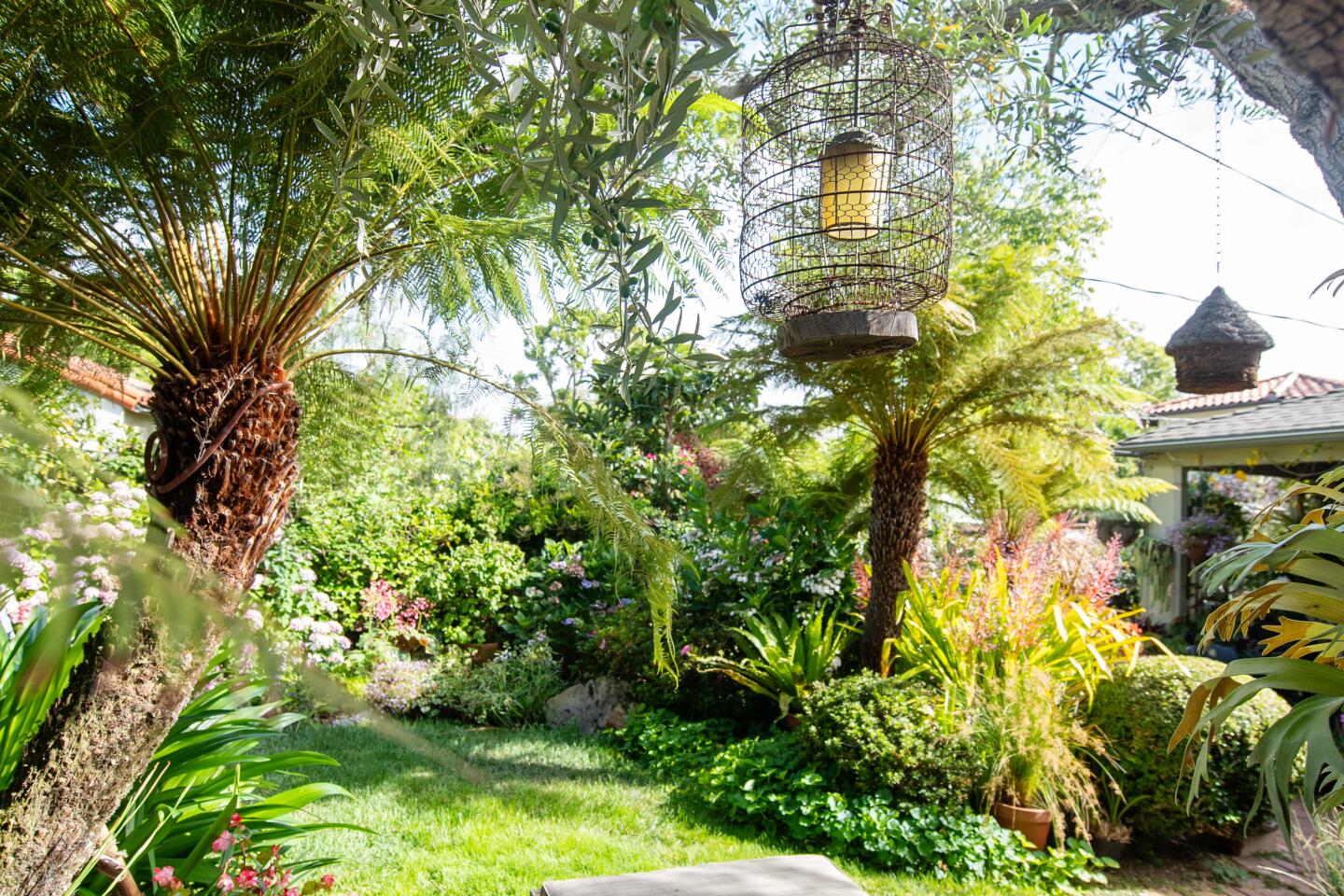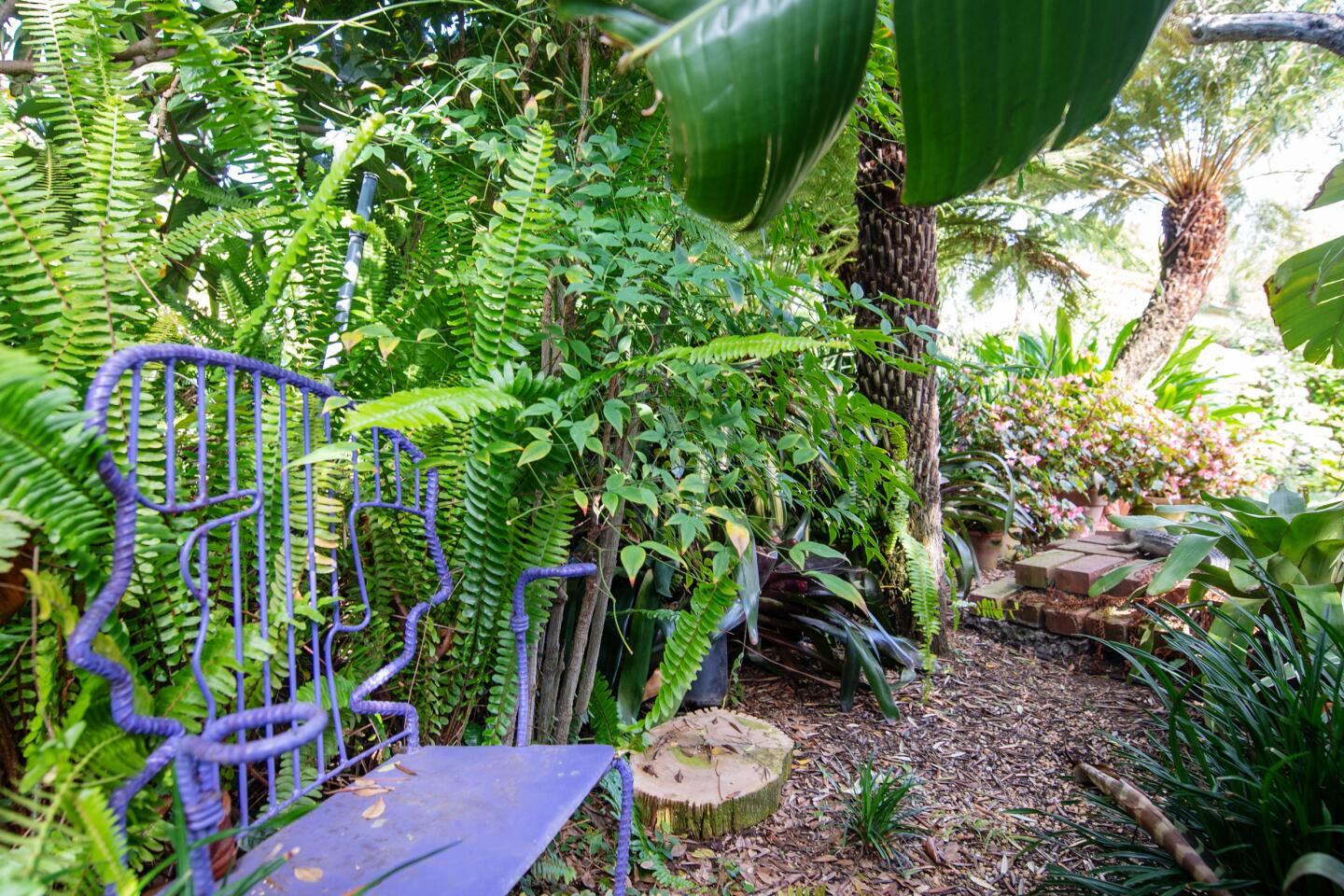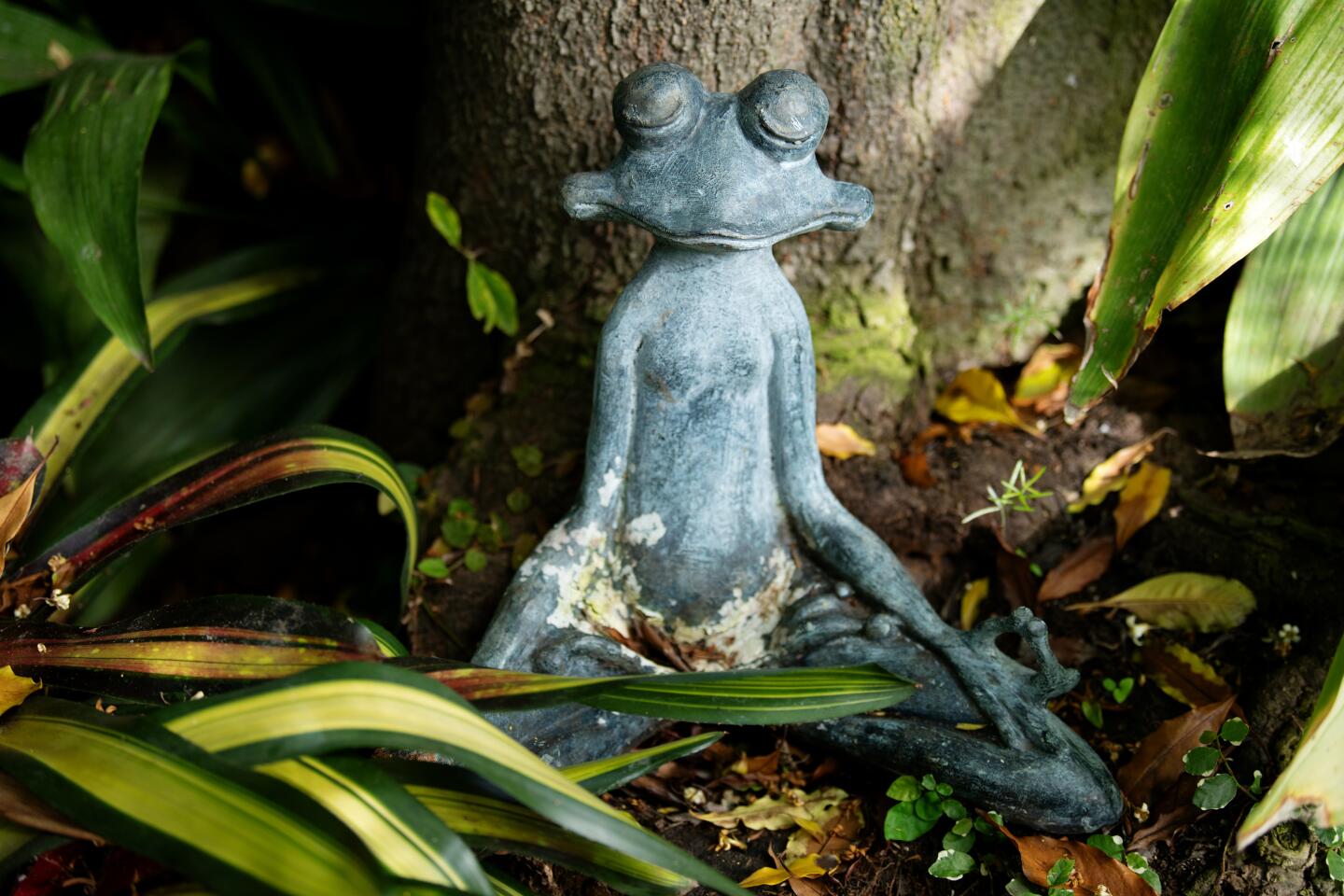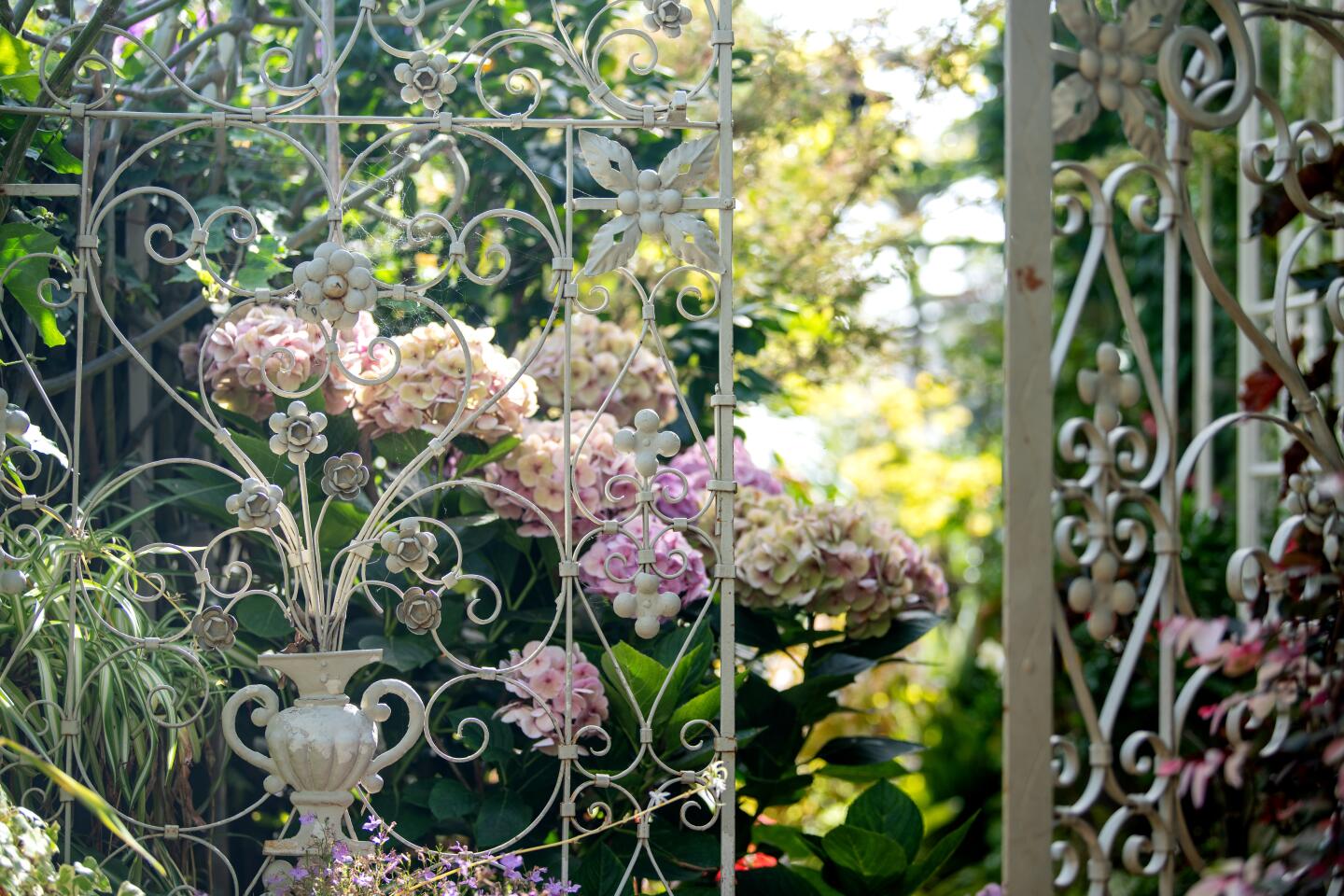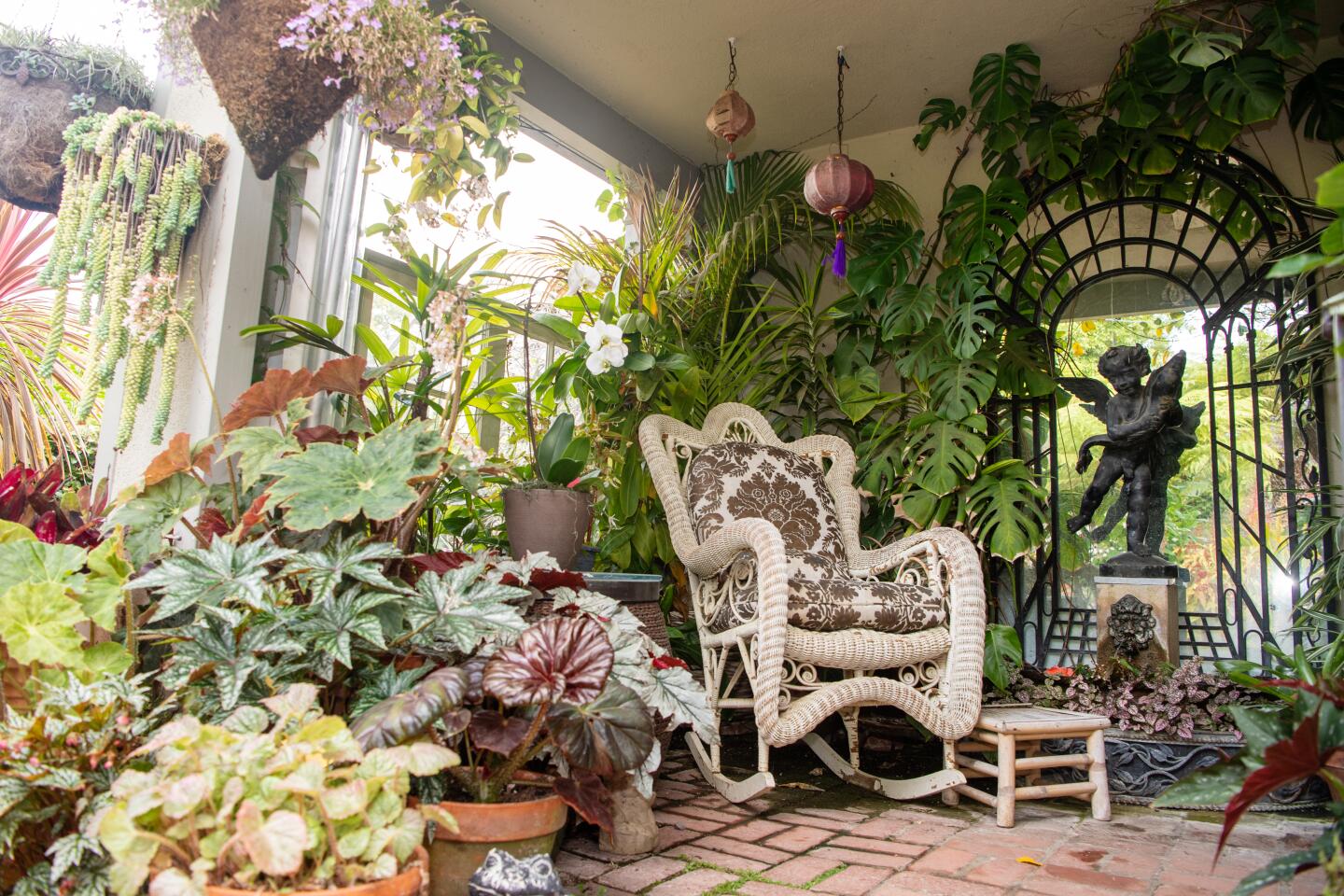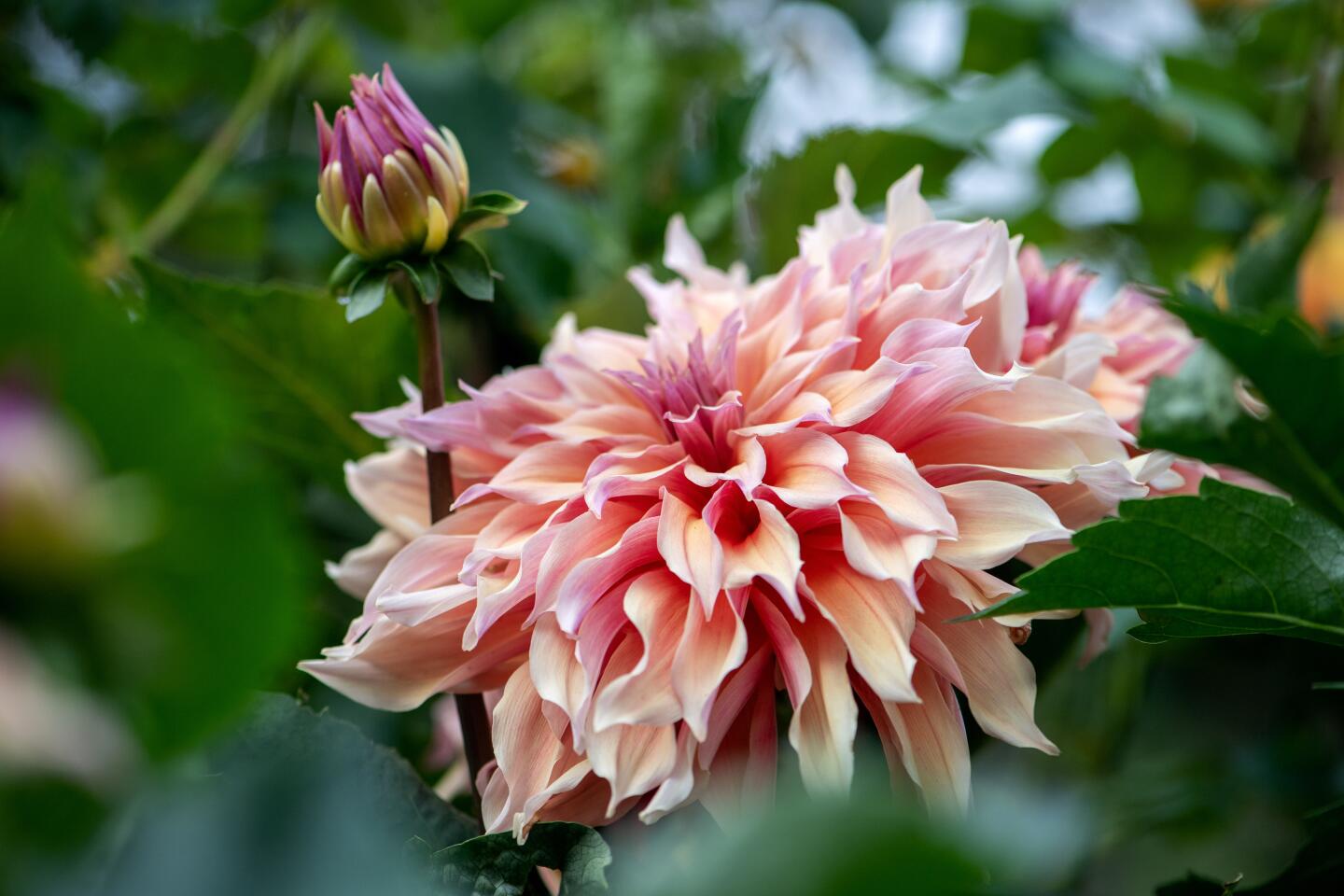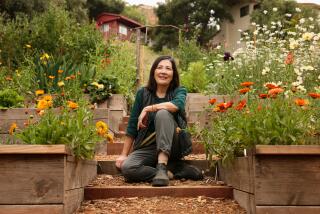Dishing dirt with ‘Catwoman’ Julie Newmar: ‘A garden is a reflection of you’

At 86, Julie Newmar, the actress who made Catwoman an icon, has a simple plan for overcoming life’s challenges: “Take everything you have and make it better.”
- Share via
At 86, Julie Newmar still has the power to bewitch. The curvy ballerina who made Catwoman a 1960s icon holds court in an office chair these days in her Brentwood home, murmuring apologies for not getting up. She’s wearing cropped leggings rolled just below her knees and a silky cream-colored blouse. Her white hair falls loosely at her shoulders, under a large floppy hat, and her lips are as bright as the electric-orange begonias hanging just outside.
“Aren’t they magnificent?” she purrs, pointing at the flowers. Then she’s moving again, spinning in her office chair to point out another magnificent begonia, blooming peachy-pink just outside her office’s wall-sized window.
‘I love, love, love that color,” she said. “I’m trying to name it... Paris Pink? No...,” she purrs again. “Hermosa.”
It’s hard to describe her energy up close, but Julie Newmar is a poster child for what 86 looks like today. Her long, famous legs aren’t as nimble anymore, but here in her sunny office, surrounded by papers, books and Catwoman artifacts, she maintains a dancer’s posture in her rolling chair and dozens of expressions — blissful, excited, amused, coy. Her hands and legs are constantly tapping, pointing, moving — and when she talks about something that makes her happy, she flings open her arms and sings the final words in a high, clear voice.
She is bright, animated and exuding positivity until someone starts a leaf blower next door. Then her eyes suddenly narrow, her face darkens and for the first time, the angry Catwoman flashes into view. “They’re the scourge of the Earth,” she hisses, flying around her office to close her doors and mute the whine. “I wrote an essay about leaf blowers and the evil they do.” (She also helped lobby the Los Angeles City Council to enact a ban of noisy, gasoline-powered leaf blowers in 1998.)
With effort, she is able to return to her main point, her philosophy about gardens, and life. “A garden is a reflection of you, it’s your presence in the world,” she said. “We live in this fabulous place, Southern California, with fabulous weather and abundance, so you share your wealth, and you share your bounty. You take everything you have and make it better.”
She was born Julia Chalene Newmeyer in Hollywood Hospital on Aug. 16, 1933, to Helene Jesmer, a former dancer with the Ziegfeld Follies, and her second husband, Donald Charles “Boomer” Newmeyer, a former Los Angeles Buccaneer football player who coached football and ran the physical education department at Los Angeles Community College. The couple met on a beach near Santa Monica. “I guess she was in a swimming suit, such as they were in the ‘30s,” Newmar said, her eyebrows arched. “They were all knitted and lovely you know, knitted so they clung to you.”
Her father also taught engineering at the college, and was knowledgeable enough to build a five-bedroom, four-bath home in Los Feliz for his growing family. The three-story house was built into a hill on Clayton Avenue with a waterfall that ran from the top to the lowest level of the property, and sweeping views of the entire city, as far west as Catalina Island.
They had to fill in the waterfalls to keep her younger brothers from drowning, but her father built his children a jungle gym and even a doll house where she could play. Her brother Peter, “blond and blue-eyed,” died in a skiing accident when he was 25. Her younger brother, John Newmeyer, was an epidemiologist at the Haight-Ashbury Free Clinic and now writes and makes wine at the Olivia Brion vineyard in Napa. “Peter was such a beautiful boy, he got the looks,” she said, “My brother John got the brains, and me, whatever... I’m still trying to catch up.”
That lower yard in Los Feliz is her earliest memory of a garden, when she was only 3. “I remember the spot exactly,” she said, eyes closed and hands arched. “I remember sitting there with my legs stretched out on the grass, and nothing was going on, but I can recall perfectly the feeling of being so beloved ... and I carry that with me in every garden I go into.”
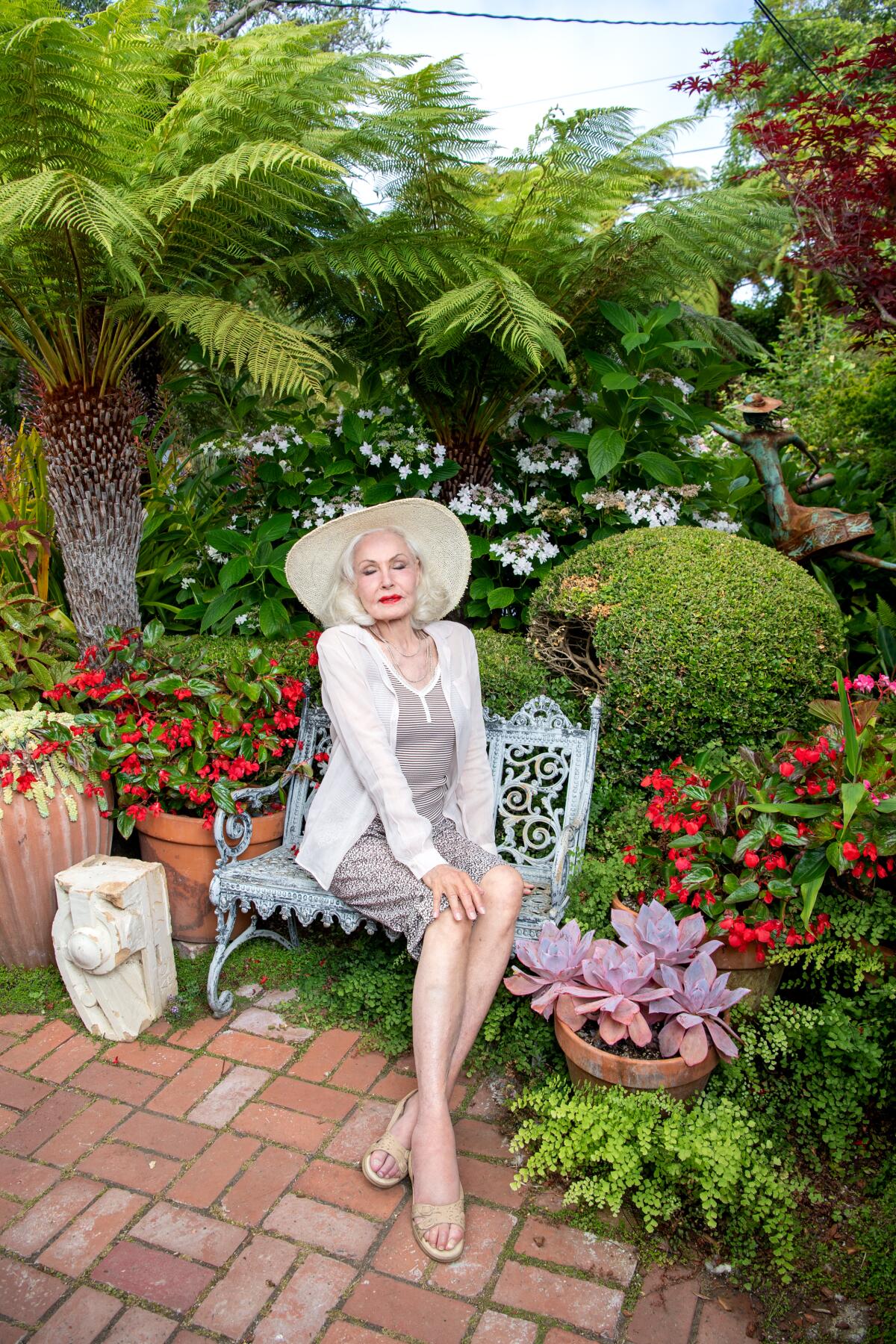
Gardens are one of the constants in Newmar’s life, even when she lived in an apartment in New York, where she earned a Tony as supporting actress in 1958 for her role as the sultry temptress in “The Marriage Go-Round” with costars Claudette Colbert and Charles Boyer, or toured the country with co-star Joel Grey in the traveling production of “Stop the World, I Want to Get Off.”
“Wherever I went, gardens would grow up around me, even on window sills,” she said. “Some people have dogs... I like leaves. I like plants, and I like flowers too. Ecstasy is big in my life.”
She has a lily, begonia and rose named after her. The centerpiece of her special rose garden near her front door is her namesake Julie Newmar rose, a butter yellow flower tinged with deep pink. In 2003, Armstrong Nursery had a contest to name the rose bred by Weeks Roses hybridizer Tom Carruth, now curator of the rose garden at the The Huntington Library, Art Collections and Botanical Gardens.“With all the love and attention I put onto flowers, I wanted a rose named after me,” Newmar said, “so I put my word out—I advise everyone to do that about what they want—I wrote something down, and I must have put it in the mailbox, because Armstrong Nurseries called me up, said ‘We have something for you,’ and...” she flung open her arms and trilled, “Ooooooh! It was my rose!”
Around West L.A., Newmar is nearly as famous for opening her gardens to charitable events and garden clubs as she is for her role as Catwoman, the most popular villain in the 1966-67 “Batman” TV series. The character was lots of fun, she said, but nowhere near as challenging as her favorite role, as Rhoda the Robot, in the 1965 TV show, “My Living Doll,” in which she played a top-secret robot with a supercomputer mind and a shapely woman’s body.
“I just arched and stretched as Catwoman,” she said, “but how do you be a robot? We’ve seen lots of cats, but how many robots have you seen that looked like Rhoda? How do you get the human-to-human connection to make people laugh?”
She’s had dozens of TV appearances and movies, including the infamously non-PC classic, “Seven Brides for Seven Brothers.” She also had a few film firsts. A decade before the famous “Goldfinger” girl was dipped in gold paint, Newmar was gilded head to toe to do an exotic dance she choreographed herself in the 1953 movie “Serpent of the Nile.” As Rhoda the Robot she was the first actor to utter “Does not compute,” a stock phrase for future sci fi shows, and she designed her famous Catwoman costume, which is now owned by the Smithsonian.
Those were the days before spandex, she said, so it was hard to make stretchy, form-fitting costumes. Her iconic jumpsuit was made from Lurex, a metallic cloth. “It didn’t have much elastic in it, but it fit like a glove—I made sure of that,” she smiled. The modest neckline was her idea, along with the slim hip-hugging belt. “They had that gold belt at the waistline but I told them, if we put it at the hips, it makes a more curvaceous body.”
Some 55 years later, she’s still just as curvy. For her 86th birthday last week, she posed for a sultry photo stretched out on a surf board wearing a brief, cream-colored chemise. The photo is pure, elegant sex, one of the few “vices,” to which Newmar demurely subscribes.
Her father was “left-brained,” she said, but her mother and grandmother raised her and her brothers as Christian Scientists, “a spiritual education I value greatly.” She never smoked or took drugs, she said “or took anything to debase me or shorten my life. I take a lot of vitamins, but I feel guilty if I take an aspirin.” So no debauchery at all in her youth? She raises her eyes and arches like a pin-up girl. “Just the good kind,” she said with a naughty smile, “the kind you don’t talk about.”
Then she gets serious. “I’m far from perfection,” she said, “but I lean toward elevating myself. I like beautiful things. I like beautiful food and manners, and I try to treat people in a way that enhances their wonderfulness. I think the happiest we are as human beings is when we can do something that benefits another.”
That philosophy is part of her passion for gardening. When she bought her Brentwood home in the early 1980s, the front yard had ivy from the house to the street and her back yard was just a “dog run,” with a lawn, three trees and a few hedges. But when she spotted a clump of violets growing in the otherwise boring back yard, she knew she’d found her home.
It would need lots of work and over time, three different landscape designers — first Jay Griffith, who created the original design, then the late Sandy Kennedy and now her successor, Bradley James Bontems, who keeps Newmar’s yard in constant bloom. Now the yards are oases of color, fragrance and shady “secret gardens” — narrow hidden paths studded with ferns and little surprises like a roaring rubber crocodile designed to engage her only child, John Jewl Smith, who was born with Down syndrome in 1981 and lost his hearing to meningitis three years later.
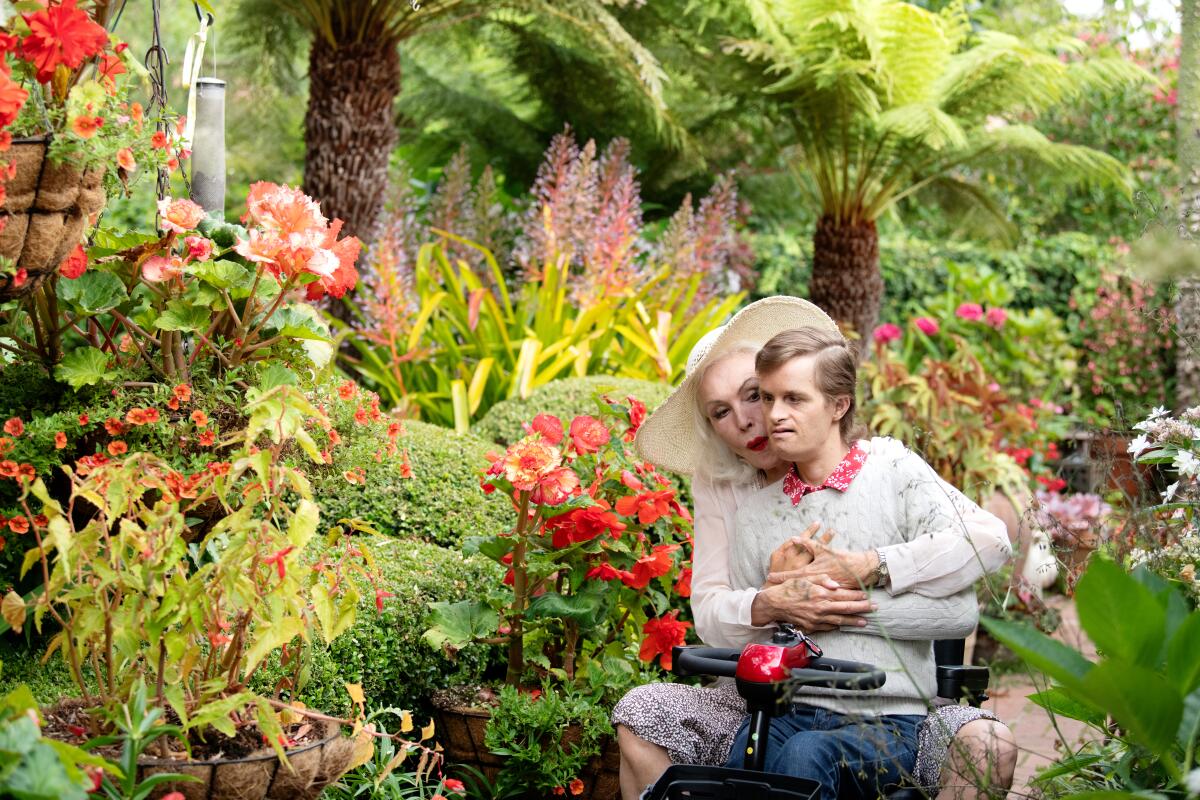
“John was born when I was 48, a last-minute baby,” she said. “He’s deaf and mute, so visual things are a delight to him... he’s such a highly developed human being he’s a blessing to be around.”
The two of them traveled all over the world when she was in her 60s, especially to Bali and other parts of Southeast Asia where they loved the soaking pools and gardens. But now that Charcot-Marie-Tooth Disease (CMT), an inherited neurological disorder, has damaged her leg muscles, and John can’t walk because of scoliosis in his spine, they mostly “travel” around their home. She has two long-time assistants who prepare meals, manage the house and help care for John, taking him to art classes and other activities, but at least once a day mother and son visit their garden. On Sundays, they camp on a two-person chaise lounge where she catches up on her reading; other days they cruise around the grounds on her electric scooter, with John sitting in her lap.
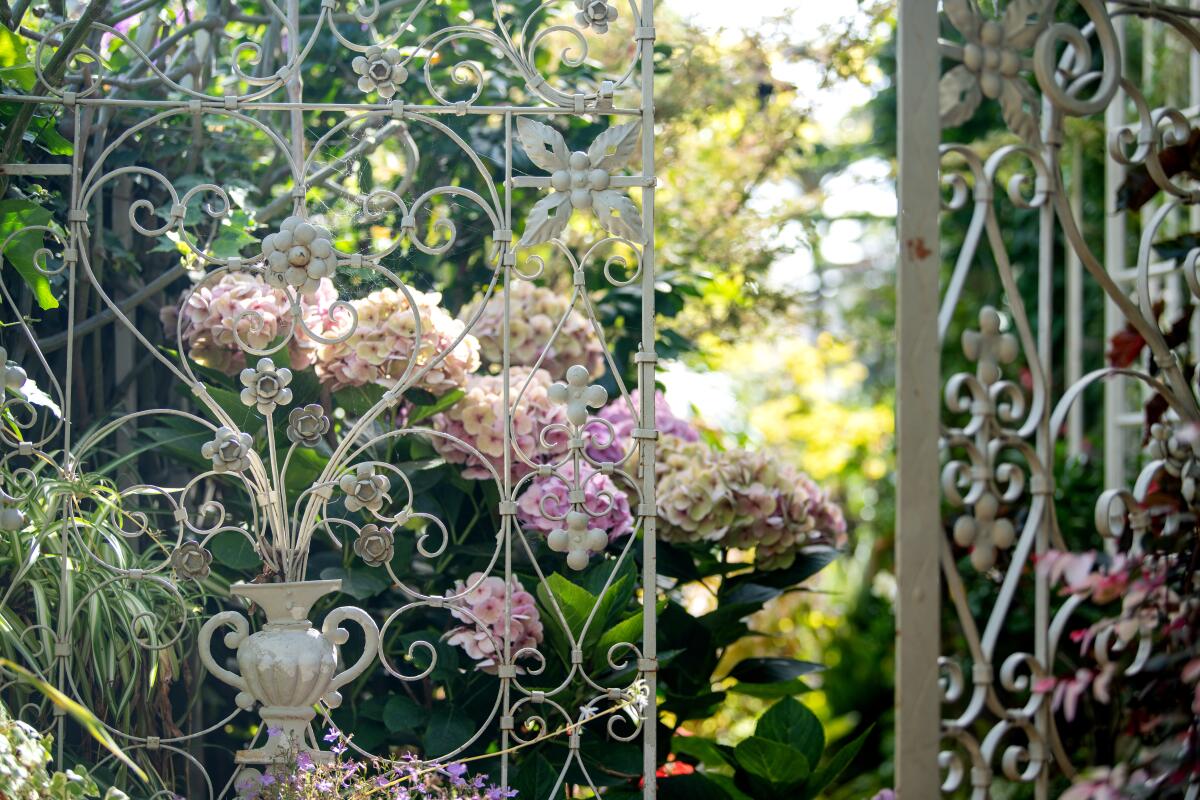
“We stay about 10 to 20 minutes in one place to see what’s going on, because unless you’re still nothing happens in the garden,” she said. “The garden heals me from all my left brain business. Whenever you get too wound up, too stressed out, I advise you to just go to a garden and be still for 10 minutes.”
Here are few of Newmar’s garden favorites:
Must-have tool
“Fine snippers... right now I’m the groomer in my garden. The men do the heavy work and I’m the manicurist with my snippers,” she said. Her landscaper, Bontems, says Newmar is very much attuned to her yard, even though she can’t do as much physically. “You can always tell gardens that people go into,” he said. “They look alive, and that’s because they’re responsive to the people who look at them.”
Favorite public garden
Newmar has seen botanical gardens all over the world, but her favorite is close to home in San Marino: The Huntington Library, Art Collections and Botanical Gardens. “There’s so many brilliant minds running that environment; their gardens are out of this world,” she said. “My favorites are the children’s garden, the indoor garden conservatory, the herb garden, the cactus garden and the rose garden.”
How she learns
She owns a copy of the “Sunset Western Garden Book,” the beloved reference book for SoCal gardeners. “It’s a lovely book,” she says, “but the advice I give most often is for people to seek out a local nursery and find the person there with the most knowledge... That’s why I love garden people. Anytime people say, ‘I’ve got a garden club who wants to visit your garden if it won’t disturb you,’ I always say, ‘Oh please disturb me!’ They have so much knowledge, they work with their hands, they’re enormously polite and appreciative and they love to know things and share things.”
More to Read
Sign up for The Wild
We’ll help you find the best places to hike, bike and run, as well as the perfect silent spots for meditation and yoga.
You may occasionally receive promotional content from the Los Angeles Times.

